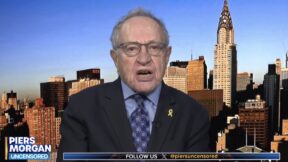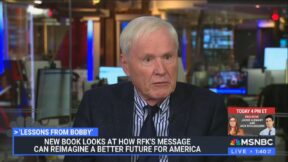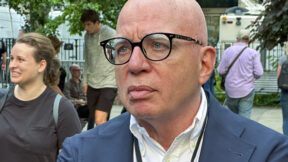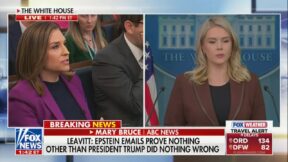Best Decade Ever? The Cable News Moments That Defined the 2010s

As the 2010s come to a close, it’s an interesting exercise to consider how future historians will help explain just what the hell happened over the past decade, which so happens to coincide neatly with Mediaite’s 10th anniversary since launching.
Mediaite was founded in the summer of 2009 which was about the same time that “opinion programming” went from cable news outlier to standard operating procedure. As a result, Mediaite quickly became focused on the intersection of media and politics, which, combined with live and unedited coverage of breaking news, led to what it has become a golden era of cable news (though that does somewhat depend on your definition of golden eras).
Mediaite has played a unique role in covering the monumental, historic and just plain crazy moments from the cable news world. For reasons that will be explained in each entry, the following is a subjective and unscientific collection of cable news moments that defined the very long, strange trip that has been the 2010s.
Tea Parties and Obamacare Town Halls
The defining story of President Barack Obama’s first years in office was his effort to pass the Affordable Care Act, aka Obamacare. In 2009 and 2010, there was a fixation on Fox News with warning that the passage of Obamacare would lead to record unemployment, outsized deficits, and a near-certain depression. As a result, many Fox News viewers, many of whom self-identified as the fiscally hawkish (and Koch brother funded) Tea Partiers, who showed up en masse to raise hell at many a Democratic congressional town hall. Clips of outraged and disruptive (and often elderly) citizens were then amplified by Fox News in what became the first ouroboros of cable news activism. As we all know, Obamacare was passed and a rebounding economy was stopped short in its tracks, resulting in record unemployment and the second great depression. Oh wait, I’m sorry. None of the fear mongering of an economic collapse came to fruition, though everyone seems to have forgotten how off those prognosticators were (many of whom still enjoy a massive platform to continue to spew conspiratorial fear tactics.)
Joe Biden’s “Big Fucking Deal”
After back and forth negotiation, some semblance of the Affordable Care Act was passed and signed in a White House ceremony by President Barack Obama. Wildly enough, the big news of that moment was not the availability of coverage options for hundreds of thousands that were previously uninsured. No, it was Vice President Joe Biden’s quip picked up by a hot mic, in which he congratulated the president’s historical moment by telling him that this was a “big fucking deal.” In the larger scheme of things, it was a harmless and somewhat interesting aside. But in the soon to be viral clip landscape, we saw first hand the power of publishing a quick and must-see video segment and just how much traffic such a unique moment could get. Mediaite was the first with that clip and the sudden flood of organic clicks very nearly crashed our servers. More importantly, internet publishers saw just how curated video clips could be so critical to the news business, a model that Mediaite very much pioneered (for better AND worse.)
Balloon Boy
This might be the weirdest story of the past 10 years. For those blissfully unaware, the long and short of this was a homemade balloon-craft was accidentally released from a Colorado family home, and word got out that a young son of the owner of the balloon was stuck inside. All cable outlets went immediately wall to wall in their coverage of a metallic balloon floating high above the Colorado foothills, with the threat of young boy possibly falling out to his death at any moment. (Cue Willy Wonka’s “the suspense is terrible, I hope it will last” moment.) Twitter got involved in the fun and emotionally detached way that it often does, and everyone seemed to overlook that the compelling live coverage might actually result in a real-time snuff film. Well, turns out the boy was not in the balloon, it was something of a promotional hoax, and the parents involved quickly revealed themselves to be the nutters they are. Technically this story initially occurred in 2009 but continued to unfold throughout the following year. More importantly, it revealed that covering a live and unfolding story, without editorial guidance, was the new thing, which went from outlier to standard operating procedure throughout the 2010s. Why report the news with context when you can just let viewers watch it unfold in real-time?
Andrew Breitbart Kanyes Anthony Weiner
One of the most influential players in the cable news ecosystem that we currently inhabit was Andrew Breitbart, the notorious founder of the site that still bears his name. There are many moments that I could highlight to illustrate his influence, but none is more apt than one that included his nemesis, Rep. Anthony Weiner. At the time, the New York congressman was caught up in a bizarre scandal, exposed by Breitbart, that involved sending inappropriate selfies to women online. Breitbart and Mediaite were the first to cover this story, and as a result, Breitbart and I developed a begrudging but collaborative relationship to get to the truth. After landing in New York, Breitbart returned a call to me, in which I revealed the news that Weiner was going to be holding a press conference on the scandal. I encouraged him to show up, since he was only a few blocks away, which he did. What happened next was that the observer (Breitbart) became the subject of the story. Since he was so central to the scandal, as Breitbart published the lewd photos, the assembled media focused on asking him questions. He eventually took the dais to respond to questions at the microphone, before Weiner even showed up. It was a fascinating, hilarious and revealing moment when the instigator became just as newsworthy as the subject, a pattern we would see unfold dozens of times over the course of the decade.
Karl Rove Melts Down Over Romney Loss
People have already forgotten, but in November of 2012, Mitt Romney and his political and media surrogates were quite confident that he would be the 45th president of the United States. Turns out, of course, that Barack Obama won reelection for his second term in a result that wasn’t as close as expected (giving rise to Nate Silver’s career.) But on the night of the election, former George W. Bush advisor Karl Rove was NOT okay with how the story was developing, even going so far as to challenge Fox News’ projection that Obama had won Ohio, and subsequently, the election. That led to anchor Megyn Kelly to march over to the “decision desk” to sort out the numbers with their analysts. This was nearly the same dynamic that occurred in 2000 when Fox News reversed their call that Gore had won Florida over Bush, which led to hanging chads and a Supreme Court decision on that election. But it was an eerily prescient moment of how alternative facts were entering the political dialogue, which we would later see come into full fruition roughly five years later.
Don Lemon Suggests A ‘Black Hole’ Responsible for Flight 370 Disappearance
The year was 2014. The economy was growing, and foreign affairs were remarkably calm. What was cable news to cover? Well for CNN the answer was the unexplained disappearance of Malaysian Air’s Flight 370. There are a number of moments that could be highlighted in the seemingly absurd obsession with the very strange news story, but the best is perhaps a comment from ascendant news anchor Don Lemon, who suggested with a straight face that a “black hole” might responsible for swallowing up the airliner. Why not. To be fair, Lemon brought this up along with other “conspiracy theories” people have been floating on Twitter, including people noting the eerie parallels to Lost and The Twilight Zone. He wondered, “is it preposterous” to consider a black hole as a possibility? Mary Schiavo, a former Inspector General for the U.S. Department of Transportation, said, “A small black hole would suck in our entire universe, so we know it’s not that.” It was a silly but entertaining moment that illustrated the challenges of 24-hour cable news panel discussions with little to no actual data to talk about.
Obama’s “Amazing Grace”
In June of 2015, the country was reeling from a racist mass shooting at a historic church in Charleston that left nine dead. President Barack Obama closed his eulogy for his late friend, the Rev. Clementa Pinckney — a week after she was gunned down by racist mass shooter Dylann Roof — and led the crowd at Emanuel African Methodist Episcopal Church in singing “Amazing Grace.” Obama first acknowledged the racist motivation behind the shooting, saying it “raises questions about a dark part of our history.” So does the Confederate flag, “a reminder of systemic oppression and racial subjugation,” he added. Then he spoke of the grace necessary to endure such troubling times, which led to what many saw as a highlight of his presidency.
Donald Trump’s Announcement
Donald Trump descended down the gold elevators at Trump Tower with future First Lady Melania Trump by his side and proceeded to announce his intentions to become the 45th President of the United States. Those watching live (and tweeting about it) were struck by the spectacle, the high-brow, low-brow olio, and his shameless vilification of Mexican immigrants as rapists and drug dealers. At the time of his announcement, his candidacy was universally dismissed as nothing but a naked play for marketing promotion, with anyone not named Ann Coulter deriding Trump 2016 as a self-promotional lark. Well, we know how that story turned out, but it was that initial announcement that didn’t just launch Trump’s political career, it also served to parade just how wrong the throngs of experts from all over the political spectrum were in dismissing the man who eventually became the Commander in Chief.
James Comey’s Press Conferences
The former FBI director had two big moments that were wildly influential in shaping the past decade of news. First was his unprecedented press conference in which he exonerated Hillary Clinton over her private email server, but with a twist. The former secretary of state was cleared of criminal wrongdoing but Comey felt the need to explain the reasons he thought her judgment was suspect. The exoneration of a crime had never been more politically damaging. Cut to just 10 days or so before the 2016 general election, and Comey reentered the political stage to announce he was reopening his investigation due to emails found on an Anthony Weiner laptop, which eventually turned out to be a non-story. The bombshell event did seem to tip the polls, at a crucial moment, a few points from Clinton to Trump, who eventually won. At the same time, Comey was sitting on a top-secret counterintelligence investigation into the Trump campaign and curious ties with Russia, but that was not revealed until later. While Trump and his allies are convinced that Comey was out to get them, evidence suggests that he helped get Trump elected. In fact, Comey was fired by Trump based on a memo written by Rod Rosenstein that illustrated just how irregular Comey’s actions towards Clinton were. Strange days indeed.
No Puppet! You’re the Puppet
Trump’s relationship with Russia has been the fodder for cable news programming for well over three years. But for many Americans, it first entered the political zeitgeist when Democratic nominee Hillary Clinton outlined very specifically how she saw Trump in line with Russian President Vladimir Putin, culminating in the claim that Trump was effectively a puppet, foreshadowing the next three-plus years of cable and broadcast news programming. Always one to push back quickly and fiercely, Trump fired back with “No puppet! you’re the puppet!” It was an instantly viral moment of projection. Three and a half years later, the American public is no closer to knowing the true driving force behind Trump’s relationship with Putin, which paints much of the body politic as either crazy conspiracy theorists or savvy critical thinkers who firmly believe the truth will win out. What’s weird is that each side thinks the other side is crazy and their side knows the truth. It’s the way we live now.
Biggest Inauguration Ever
President Donald Trump had just taken the oath of office and controversy had already found him. Amidst reports of low attendance at his inauguration, the White House quickly assembled a press conference in which newly-appointed Press Secretary Sean Spicer absolutely lashed out against reporters. Spicer turned his ire towards those who noted that Trump didn’t have a particularly large crowd for his inauguration compared to past presidents, saying that these media figures were working to “minimize the enormous support” that got Trump elected, and that it was “shameful and wrong” to put out “inaccurate” numbers and pictures about the crowds. “This was the largest audience to witness an inauguration. Period!” Spicer said, infamously. This historic moment signaled the beginning of a contentious relationship between the Trump administration and the political media who covered him, but it also gave rise to perhaps the most enduring comment that defines politics in the opinion media age. What Stephen Colbert once comedically coined as “truthiness” came to real fruition as Kellyanne Conway defended Spicer’s comments as “alternative facts,” which has been a constant drumbeat by both sides of the political spectrum since that fateful January 2017 day.
Jim Acosta vs the White House
The contentious relationship between the Trump administration and the press is best captured by CNN’s Jim Acosta and his battle with the White House press team. Pro-Trump media love to deride Acosta for what they see as grand-standing, while many in Acosta’s camp laud him for fearlessly speaking truth to power. And that conflict was paraded nearly every press briefing and press conference held by Trump, and neither Acosta nor the president (and his aides) seemed willing to back down. The conflict peaked when a White House intern approached Acosta and tried to physically remove the microphone from the CNN reporter, which turned into a bit of a kerfuffle that, predictably, highlighted either the media’s unwillingness to be professional OR the White House silencing its toughest critics. In the months that followed, cooler heads prevailed and the Acosta vs. White House drama abated, largely aided by the cessation of the regular press briefings.
Trump Admits He Asked Ukraine to Investigate Biden, Asks China Too!
In lieu of regular press briefings, Trump filled the void with impromptu gaggles in the Oval Office or on the White House lawn. One such event featured a moment that has played heavy in the ongoing impeachment proceedings over Trump asking a foreign entity to investigate his political rival Joe Biden, details of which were revealed by a whistleblower complaint and phone call transcript released by the White House. The scandal, which led to the third impeachment in U.S. history, was one Trump owned by admitting that he had asked Ukraine to investigate Biden. He even went one step further by suggesting that he hoped China would do the same. It’s in line with Trump’s tendency to challenge the media to call him out as a disruptor, but it also may have had a serious impact on the historic impeachment drama presenting an existential threat to his presidency.
This is an opinion piece. The views expressed in this article are those of just the author.




